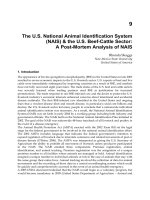Mechanics of Microelectromechanical Systems - N.Lobontiu and E.Garcia Part 7 pot
Bạn đang xem bản rút gọn của tài liệu. Xem và tải ngay bản đầy đủ của tài liệu tại đây (1.12 MB, 30 trang )
168
Chapter 3
The terms in the right-hand side of Eq. (3.111) are the axial stiffnesses of the
two compliant members, taken with respect to their local frames (their x-axes
are parallel to their length dimensions).
The spring stiffness about the out-of-the-plane motion (the z-direction)
of the mass can be found by also using Fig. 3.37. A force is applied at
point 1 about the z-direction and the corresponding (out-of-the-plane)
displacement can be determined by considering bending and torsion of the
two compliant members. The z-direction stiffness of the half-model is:
which is valid when the two compliant segments are of constant cross-
sections. The whole folded-beam microspring is formed of two parallel-
connection identical parts (as the one sketched in Fig. 3.37), and therefore the
stiffness of the full microspring is:
Example 3.13
In a folded-beam microsuspension, the long legs cannot exceed a
maximum length of What is the length of the short legs
which would produce a specified stiffness of the
microsuspension about the motion direction for a given rectangular cross-
section and material properties E = 130 GPa) ?
Solution:
Figure 3.38 Stiffness for a folded-beam suspension
If the short leg length is connected to the length of the long leg as:
3. Microsuspensions
169
and for the given moment of inertia and Young’s modulus, the stiffness
depends on and c, as shown in Fig. 3.38. The stiffness decreases with
and c increasing. For the values of and the solution is c = 0.94, and
therefore the length of the short leg is
Example 3.14
A sagittal suspension and a folded-beam spring can be inscribed within
the same a x b rectangular area What are their
stiffnesses about the motion direction, in the case both designs have the same
cross-section of their compliant members ? Consider that and
for the sagittal spring, and that for the folded-beam suspension.
Solution:
When both designs are inscribed in the given rectangular area, the main
dimensions of the sagittal suspension are related by the following
relationships:
which yield The conditions for the folded-beam design are:
and they result in:
Figure 3.39 stiffness ratio of sagittal spring versus folded-beam spring
170
Chapter 3
By also using the other numerical values, one can study the sagittal-to-
folded-beam stiffness ratio which is plotted in Fig. 3.39 as a function of
the length of the folded beam. It can be seen that the sagittal design is
approximately 2.5 times stiffer than a corresponding folded-beam
configuration for small lengths of the middle compliant leg.
3.
MICROSUSPENSIONS FOR ROTARY MOTION
Several microsuspensions are studied in this section, which are designed
for implementation in rotary-motion micromechanisms. Similar to the
microsuspension configurations that are used in linear-motion applications
and which were shown to be able to accommodate rotary motion as well, the
rotary microsprings can also be sensitive to linear motion.
3.1
Curved-Beam Springs
rigid bodies undergoing translatory motion. A microspring design is analyzed
here that can function as a torsional suspension for rotary motion. Figure
3.40 is a two-dimensional sketch showing several identical curved springs
that are attached to a central hub at one end and to a tubular shaft (which is
concentric with the inner hub) at the other end. The set of curved beams (they
can also be straight beams) act as both suspensions and springs, as they
connect the hub and the central shaft and elastically oppose the relative
rotary motion between the two rigid components.
Figure 3.40 Set of curved beams acting as springs for the concentric hub-hollow shaft
system
It is of main interest to find the total stiffness of the curved spring set in
terms of the relative rotation between hub and the outer hollow shaft. Under
3. Microsuspensions
171
the action of an external torque that is applied to the outer shaft, for
instance (case where the inner hub is supposed to be fixed), the relative
rotation angle is expressed by the equation:
The torsion stiffness is:
where n is the number of beams and is the rotation stiffness of the
curved beam shown in Fig. 3.41 and which is defined by a radius R, a center
angle and a constant rectangular cross-section.
Figure 3.41 Curved spring with defining planar geometry
This stiffness can be determined by utilizing the compliance formulation that
has been introduced in Chapter 1 for a relatively-thin curved beam. It has
been shown there that the in-plane deformation of a curved beam is defined
by a set of six compliances, which have explicitly been derived, and arranged
into a compliance matrix – Eq. (1.127). It is known that the inverse of the
compliance matrix is the related stiffness matrix, and therefore Eq. (3.26)
also applies to this case. Through inversion of the compliance matrix of the
right-hand side in Eq. (3.26) and by using the corresponding individual
compliance Eqs. (1.156) to (1.161), it is found that:
Of interest is also the suspension capacity of the curved spring set as the
self-weight of the supported member (the outer hollow shaft in this case) can
displace it downward about the z-axis. The corresponding linear stiffness
about the z-axis can be calculated as:
172
Chapter 3
where is the out-of-the-plane stiffness of one curved spring. The six
out-of-the-plane compliances of a thin curved member have explicitly been
formulated in Eqs. (1.139) to (1.143) and Eq. (1.163), respectively. The
linear stiffness can be found by inverting the compliance matrix of Eq.
(1.137), which results in:
As a consequence, the individual stiffness is:
Example 3.15
Find the tip angle of a curved microbeam which is part of a rotary
(torsional) spring suspension which connects an inner shaft of diameter d to
an outer hub of interior diameter D (D = 2d), in a way that would maximize
the spring’s compliance with respect to an external torque for a given
rectangular cross-section and material properties. Consider that
and E =125 GPa.
Solution:
The tip angle of the curved spring can be expressed as:
and therefore this condition has to be used in Eq. (3.119), which gives the
torsional stiffness of such a spring. The stiffness of interest is plotted in Fig.
3.42 in terms of the shaft diameter d and the radius of the curved spring R by
utilizing the given numerical values. As the figure shows, the stiffness is
larger for larger values of d and smaller values of R. As a consequence, one
has to select these parameters accordingly, namely small values for d and
large values for R.
3. Microsuspensions
173
Figure 3.42 Torsion stiffness plot
3.2
Spiral Springs
Another microsuspension variant for rotary motion is the spiral spring.
Two designs will be presented next, the spiral spring with small number of
turns and the spiral spring with large number of turns. Both designs will
consider thick and thin configurations.
3.2.1
Spiral Spring with Small Number of Turns
3.2.1.1
Thick Spiral Spring
A spiral spring that has a small number of turns is sketched in Fig. 3.43.
The inner end is fixed whereas the outer one is free. The outer (maximum)
radius is and the inner (minimum) one is
Figure 3.43 Spiral spring with small number of turns
174
Chapter 3
An arbitrary point is situated an angle measured from the vertical line
passing through the fixed end.
The radius r corresponding to the generic point P of Fig. 3.43 can be
calculated in the case it varies linearly as:
where is the maximum angle subtended by the spiral. The aim here is to
determine the in-plane compliances that relate the loads which
are shown in Fig. 3. 43, to the corresponding displacements and
The Castigliano’s displacement theorem is applied in order to find the six
compliances of the 3 x 3 symmetric compliance matrix. In the case of a
relatively thick spiral spring (where the maximum radius is less than 10
times the cross-sectional width w), the bending energy is expressed in Eq.
(3.52) and the bending moment is:
The resulting in-plane compliances are:
3. Microsuspensions
175
Example 3.16
What is the torsional stiffness of a thick spiral spring with square cross-
section microfabricated of a material with E = 135 GPa when the
maximum angle is 270° ? Also consider that and
Solution:
The definition torsional stiffness is the inverse of the torsional compliance.
As Eq. (3.131) shows, the eccentricity e needs to be calculated. An average
radius of is taken which gives an eccentricity of by way
of Eq. (1.122), Chapter 1. By substituting the other numerical values into Eq.
(3.131), the torsional stiffness is
3.2.1.2
Thin Spiral Spring
For a thin spiral, according to the theory presented in Chapter 1, only the
bending moment is taken into consideration, and the elastic deformations are
calculated by means of the equations pertaining to straight beams. By
applying again Castigliano’s displacement theorem, and by considering the
bending moment of Eq. (3.125), the six in-plane compliances which are of
interest can be expressed as:
176
Chapter 3
Example 3.17
Consider that point 1 in Fig. 3.43 is confined to move about the x-
direction. Find the stiffness of a thin spiral spring with small number of turns
knowing and
Solution:
The stiffness about the x-direction in this case can be found after
determining the reactions and When taking into account that the y-
displacement and z-rotation at point 1 are zero, the unknown reactions can be
written in terms of in the form:
where and are
functions of
and
After finding the x-
displacement at point 1 as a function of and the geometry/material
properties defining the spiral, the corresponding stiffness about the x-direction
(according to the definition) can be expressed as:
The function is too complex to be presented here, but Fig. 3.44
shows the variation of the stiffness about the x-direction as a function of the
3.
Microsuspensions
177
radii and for the particular parameters given here. It can be noticed that
that decreases quasi-linearly with and increasing.
Figure 3.44 Stiffness as a function of and
Example 3.18
A thin spiral spring has to be designed within a circular area of radius R.
Find the rectangular cross-section of the spring with a given thickness-to-
width ratio and a given ratio of the maximum-to-minimum radii that would
produce the best compliance in torsion for a given material. Consider that
and E = 150
GPa.
Solution:
Figure 3.45 Stiffness ratio
The following relationships:
178
Chapter 3
are substituted into Eq. (3.137)‚ which defines the torsion compliance. The
corresponding definition stiffness is the inverse of the compliance. The plot of
Fig. 3.45 is drawn in terms of and It can be seen that the influence of
is not marked in comparison to The latter parameter should be small in
order to reduce to stiffness (and implicitly to increase the compliance).
3.2.2
Spiral Spring with Large Number of Turns
The case of a spiral with a large number of thin turns‚ as the one pictured
in Fig. 3.46‚ is studied now.
Figure 3.46
Spiral with a relatively large number of turns
The outer end is clamped whereas the inner end is fixed to a shaft that can
rotate under the action of a torque The torsion stiffness (relating to
the rotation angle is of interest here. The bending moment at a generic
point of coordinates x and y is:
The following approximate equilibrium equation applies:
By combining Eqs. (3.141) and (3.142)‚ the bending moment becomes:
By applying Castigliano’s displacement theorem‚ the forces and can be
expressed in terms of and‚ in the end‚ the rotational stiffness of the spiral
spring is found to be (as also shown in Chironis [2] and Wahl [3]):
3.
Microsuspensions
179
where l is the total length of the spiral.
Problem
s
Problem 3.1
The poly silicon fixed-guided beam of Fig. 3.4 has a length of
and a constant rectangular cross-section with and
Young’s modulus is E = 150 GPa. The beam is used in an accelerometer
whose measuring unit can read displacements with a precision of
What is the minimum force that can be detected by this microsystem ?
Answer:
Problem 3.2
An inclined beam is used in a static application where the stiffness about
the active direction of motion‚ is two times smaller than it should be.
Determine the inclination angle of the beam that would achieve the stiffness
objective (see Fig. 3.6 (b)). Known are
Answer:
Problem 3.3
The ratio of the stiffness to the stiffness of a bent beam spring‚ as
the one sketched in Fig. 3.9‚ has to be of a fixed value r. What is the length of
the beam’s square cross-section side that would produce this result and what
is the permissible range of r ? Consider that
Answer:
and therefore:
Problem 3.4
A U-spring is designed according to the prescriptions of configuration #
1, Fig. 3.12. It has a constant rectangular cross-section with and
180
Chapter 3
and Young’s modulus is E = 130 GPa. The application where the U-
spring is incorporated into requires that and Determine the
length that produces a maximum stiffness of = 0.3 N/m about the direction
of motion (calculated according to the definition).
Answer:
Problem 3.5
A configuration # 2 U-spring (see Fig. 3.16) has to replace a
configuration # 1 U-spring (see Fig. 3.12) in order to increase the stiffness
about the active direction of motion‚ If the geometrical envelope‚ the
cross-section and the material properties are identical for the two designs‚
what is the factor of improvement in that is achieved by this design
change ? Consider that and for configuration # 1 and use the
stiffness expressions according to the definition.
Answer:
The stiffness of configuration # 2 is 1.226 times larger than the stiffness
of configuration # 1.
Problem 3.6
A configuration # 3 U-spring‚ as the one shown in Fig. 3.17‚ is used in a
microaccelerometer dynamic application instead of a configuration # 1 U-
spring in order to reduce stress concentration at the sharp corners. Known are
E
= 150 GPa and G = 60 GPa. Find the change in the out-of-the-plane stiffness.
Answer:
Stiffness for configuration # 1 is 19.97 N/m.
Stiffness for configuration # 3 is 6.37 N/m.
Problem 3.7
A bent beam spring (shown in Fig. 3.9) and a configuration # 1 U-spring
(as sketched in Fig. 3.12) are microsuspension candidates in an application
where the compliance about the in-plane y-direction has to be minimum.
When both springs have the same square cross-section are built of
the same material and‚ additionally‚ the following geometry constraints have
to be complied with: (1 is the leg length of the bent
beam spring)‚ which design is best suited for the task ?
Answer:
The compliance of the bent beam spring is 4.57 times larger than the
compliance of the U-spring‚ so the U-spring is the option.
3.
Microsuspensions
181
Problem 3.8
A basic serpentine spring of very thin cross-section (t << w) with a given
value of its long leg‚ has to be stiff about the out-of-the-plane (z) direction
and compliant in torsion. Select a length which will satisfy these
requirements. (Hint: Analyze the ratio).
Answer:
The ratio is maximum (which means the numerator is maximum and the
denominator is minimum) for a given when is minimum.
Problem 3.9
What is the main compliance of a linearly-scaled serpentine spring that
contains two units ? The length of the smaller unit’s long leg is
the shorter leg’s length is and E = 140 GPa.
Answer:
The compliance is the sum of the two units compliances;
Problem 3.10
Compare the two linear in-plane compliances of a bent beam serpentine
spring that is microfabricated of polysilicon with E = 130 GPa‚ G = 40 GPa‚
Answer:
Problem 3.11
Find the out-of-the-plane deflection of a bent beam serpentine spring
with E = 135 GPa‚ G = 42
GPa under the action of a force of Also calculate the deflection of
a similar bent beam spring with under the same loading and having all
other geometrical and material properties identical to the ones of the bent
beam serpentine spring.
Answer:
Stiffness of bent beam serpentine spring is 36.219 N/m.
Stiffness of bent beam spring is 11.808 N/m.
Problem 3.12
A configuration # 1 U-spring (with the boundary conditions of Fig. 3.12)
with and a sagittal spring (Figure 3.35)‚ both inscribed in the same
rectangular area are possible solutions for an application where
relatively high (definition) stiffness is required. Determine the best design
solution‚ when E = 140 GPa.
182
Chapter 3
Answer:
Stiffness of U-spring is 10.24 N/m.
Stiffness of sagittal spring is 372.46 N/m (for
Problem 3.13
A folded-beam spring as the one sketched in Fig. 3.37 is microfabricated
by a technology which imposes a thickness of Find the cross-
sectional width w of its two compliant legs assuming that
E = 150 GPa and when a stiffness needs to be produced.
Answer:
Problem 3.14
Find the number of curved springs with
and E = 130 GPa‚ which combined as shown in Fig. 3.40 will be able to
produce a rotation angle of 2° under an external torque of
Answer:
n = 4
Problem 3.15
A thin spiral spring with a small number of turns and with its external
end free‚ needs to have its compliance 5 times larger than in an
application where and Determine the external radius
Answer:
References
1. W.C. Young‚ R.G. Budynas‚ Roark ’s Formulas for Stress and Strain‚ Seventh Edition‚
McGraw Hill‚ New York‚ 2002.
2. N.P. Chironis – Editor‚ Spring Design and Application‚ McGraw-Hill Book Company‚ New
York‚ 1961.
3. A.M. Wahl‚ Mechanical Springs‚ McGraw-Hill Book Company‚ Second Edition‚ New York‚
1963.
Chapter 4
MICROTRANSDUCTION: ACTUATION AND
SENSING
1.
INTRODUCTION
This chapter analyzes the main forms of MEMS actuation and sensing‚
also known together as transduction methods. The actuation basically
converts a form of energy‚ such as electric or thermal‚ into mechanical
motion by various means. The performance of a specific actuation method is
usually qualified through mechanical amounts‚ such as force/moment or
linear/rotary displacement. Conversely‚ in sensing‚ an already-existing
mechanical motion or the effects of the microdevice interaction with its
environment need to be evaluated by transforming the mechanical energy
corresponding to motion into another type of energy‚ which can directly be
measured.
On the other hand‚ one microdevice can be used as either actuator or
sensor. An electrostatic comb drive‚ for instance‚ can function as an actuator
when is supplied with electric energy and sets into motion a microdevice‚ but‚
equally‚ it can be used as a sensor in a microdevice that is actuated by a
different source in order to measure displacements by quantifying electric
capacitance changes. However‚ the relationship between mechanical
displacement and capacitance variation is unique. In other words‚ a unique
equation governs a specific transduction form‚ which can be used
conveniently to describe either actuation or sensing‚ through calculation of
the corresponding output amount in terms of the input quantities.
Studied in this chapter are transduction methods such as thermal‚
electrostatic‚ electromagnetic and magnetic‚ piezoelectric‚ piezomagnetic‚ by
means of shape memory alloys‚ and through bimorphs and multimorphs.
Transduction is energetically imperfect‚ as one form of energy cannot
convert into another form of energy without losses (which can be substantial
at times)‚ but this subject‚ which needs further research‚ especially regarding
the mechanisms that are involved in energy conversion‚ is not approached
here.
184
Chapter 4
2.
THERMAL TRANSDUCTION
2.1
Introduction
The thermal actuation has the benefit of producing relatively large forces
and/or displacements but these performances come at the expense of large
input energy and at relatively low frequencies because of the time necessary
to reach thermal equilibrium (which is necessary for reproducible operation).
The principle of linear thermal expansion is sketched in Fig. 4.1 where a
fixed-free bar of length 1 is shown that expands through heating by a quantity
which can be determined as:
where is the material coefficient of linear thermal expansion (measured in
1/°C) and is the temperature variation. Notice that when the bar
compresses and vice versa‚ the bar expands when the
temperature increases as the case is with the example shown in Fig.
4.1.
Figure 4.1 Fixed-free bar expanding axially under a temperature increase
This device is probably the simplest thermal actuator as the free end 1 can be
coupled to a microdevice at a port where actuation is needed. The thermal
displacement of Eq. (4.1) can also be produced by an equivalent force that
acts at the free end 1‚ and which is:
where E is the material Young’s modulus and A is the cross-sectional area.
Equation (4.1) has been used to determine the final form of Eq. (4.2).
The output capacity of an actuator‚ such as the simple thermal bar‚
depends on the load is has to overcome. Let us assume that an axial load is
applied opposing the free expansion of a fixed-free bar‚ and let us consider
that this force can increase up to a certain level that will completely
4.
Microtransduction: actuation and sensing
185
annihilate the thermal expansion of the heated bar. As long as the external
force is less than this threshold value‚ usually called bloc force‚ the total
displacement of the tip of the bar is the difference of two opposing
deformations‚ namely:
where F is the external force. Equation (4.3) can be rewritten in the form:
There is a linear relationship between the external force and the total linear
expansion‚ as Eq. (4.4) indicates. For zero axial displacement the
force is maximum and equal to the bloc force:
whereas its minimum value of zero occurs for the free displacement
which is:
Several of the actuators that are going to be presented in this chapter behave
similarly to the thermal actuator‚ and their force-displacement characteristic
can be written in the form:
The linear relationship of Eq. (4.7) is plotted in Fig. 4.2.
Figure 4.2
External force working against constant actuation force in terms of the output
displacement
186
Chapter 4
As Eq. (4.7) suggests‚ this relationship is fully determined by means of the
two parameters‚ the bloc force and the free displacement and therefore
these two amounts will be formulated for the types of actuators that behave
similarly.
2.2
Bent Beam
By changing the boundary conditions of the fixed-free bar analyzed
previously‚ bending and different levels of actuation can be achieved through
thermal heating‚ such as in the example of the bent beam (discussed also by
Que et al. [1] and Gianchandani and Najafi [2] for instance) that is sketched
in
Fig. 4.3.
Figure 4.3 Bent beam: (a) Geometry and boundary conditions; (b) Half model with
actuation force and support reactions
When the temperature increase does not reach levels that would produce
buckling of the bent beam (and which will be analyzed later in this book)‚ the
mutually constrained thermal expansion of the two beams making up the
device will result in a linear motion by the combined bending of the beams‚
as suggested in Fig. 4.3 (a). Because of the system’s symmetry‚ it is
sufficient to analyze only half of the model‚ as indicated in Fig. 4.3 (b). Point
1 will be forced to move about the y-axis. By applying a temperature
increase to the component of Fig. 4.3 (b)‚ the free expansion is impeded by
the two supports‚ and the only way the member can deform is through
bending‚ which will move the end 1 vertically upwards in the figure. Figure
4.
Microtransduction: actuation and sensing
187
4.4 is the picture of a real thermal actuator which consists of five bent beams
that are placed in parallel‚ in order to enhance the output force capabilities.
Figure 4.4 Bent beam actuator realized by the MUMPs technology
In order to determine the two performance parameters that have been
defined for a straight free-fixed bar under thermal heating‚ and which are the
free displacement and the bloc force‚ it can be considered that the beam is
subject to a force which is the equivalent of the free expansion at end point 1‚
as given in Eq. (4.2)‚ and which has been denoted as (to highlight its
thermal nature) in Fig. 4.3 (b). As a result of boundary constraints‚ the
support reacts with the force and the moment which have to be
determined first. This can be done by using the conditions of zero
displacement about the x-axis and zero rotation about the z-axis at point 1‚
together with Castigliano’s displacement theorem. The deflection at point 1
about the y-direction can be found similarly after calculating and by
applying the same theorem and by considering that bending and axial
deformations produce the total strain energy. The equation for is:
where A and are the cross-sectional area and moment of inertia about the
z-axis‚ respectively. Equation (4.8) indicates that the deflection at point 1
depends linearly on the temperature increase and non-linearly on the
geometric parameters defining the half bent beam. An example will be
analyzed next that studies the free displacement in terms of the defining
geometry.
188
Chapter 4
Example 4.1
A bent beam thermal actuator has a rectangular cross-section defined by
the width w and the thickness t. Known are the following material properties
which correspond to polysilicon: E = 130 GPa and For a
temperature increase of analyze the influence of the geometry
defining the bent beam on the free displacement.
Solution:
Figures 4.5 and 4.6 are two plots showing the variation of the output
displacement in terms of the defining geometry. For the simulation of Fig.
4.5 it has been considered that and
Figure 4.5 Free displacement in a bent beam as a function of beam length and inclination
angle
Figure 4.6 Free displacement in a bent beam as a function of cross-section width
The simulation of Fig. 4.6 took the same numerical values‚ except for w‚
which is the variable here‚ and for and It can be seen that
the free displacement decreases in a non-linear fashion when the inclination
4.
Microtransduction:
actuation and sensing
189
angle increases‚ and is larger for larger lengths – Fig. 4.5‚ as expected.
Increasing the cross-sectional width reduces the free displacement‚ as shown
in Fig. 4.6. The thickness t of the beam cancels out in Eq. (4.8).
The bloc force‚ as previously introduced‚ is the force that has to be
applied at point 1 about the y-direction in order to annihilate the output y-
displacement at the same point produced by application of a temperature
increase – Fig. 4.3 (b). The force is determined by following a procedure
similar to the ones already presented and its equation is:
Example 4.2
Analyze the relationship between the bloc force and the geometric
parameters that define the bent beam actuator of Example 4.1.
Solution:
The same numerical values have been used here as in the case of the
output displacement studied in Example 4.1. Figures 4.7 and 4.8 are two
plots that show the variation of as a function of the defining geometric
parameters‚ namely inclination angle‚ length and cross-sectional dimensions.
The plot of Fig. 4.7 indicates that the bloc force is larger at smaller
lengths where it also reaches a local maximum. For longer elements‚ the bloc
force is almost constant when the inclination angle varies. However‚ the bloc
force is larger for small inclination angles‚ as seen in Fig. 4.7. As expected‚
the bloc force increases quasi-linearly with increasing the cross-sectional
dimensions w and t‚ as shown in Fig. 4.8.
Figure 4.7
Bloc force in a bent beam as a function of beam length and inclination angle
190
Chapter 4
Figure 4.8 Bloc force in a bent beam as a function of cross-sectional width and thickness
Example 4.3
Compare a fixed-free bar and a bent beam half model in terms of their
free displacement and bloc force assuming they have identical lengths‚ cross-
sections‚ material properties and are subjected to the same temperature
increase.
Solution:
It is useful to analyze the following two ratios that relate the output
displacement and bloc force of the two thermal actuators‚ namely:
where the subscripts bb and s denote bent beam and straight‚ respectively.
Figure 4.9 Bent beam versus straight bar in terms of free displacement as a function of
inclination angle and length
By using Eqs. (4.8) and (4.6)‚ the first ratio of Eq. (4.10) becomes:
4.
Microtransduction:
actuation and sensing
191
and is larger than one‚ which indicates that the displacement produced by a
bent beam is always larger than the axial deformation of a fixed-free beam.
Figures 4.9 and 4.10 are the plots of the ratio defined in Eq. (4.11) in terms
of the geometric parameters. The free displacement of the bent beam can be
20 times larger than the one of a straight bar‚ for smaller inclination angles
and larger lengths‚ as shown in Fig. 4.9. For larger cross-sectional widths‚ the
free displacement ratio of Eq. (4.11) decreases almost to unity‚ as illustrated
in
Fig. 4.10.
Figure 4.10 Bent beam versus straight bar in terms of displacement output as a function of
leg width
The bloc force ratio of Eq. (4.10) becomes‚ by way of Eqs. (4.9) and
(4.5):
This time‚ as Eq. (4.12) suggests‚ the ratio is less than 1‚ and therefore the
bloc force of the fixed-free bar is always larger than that of the corresponding
bent beam. Figures 4.11 and 4.12 contain two similar plots showing that the
bloc force of the bent beam increases relative to the one of the fixed-free bar
for larger cross-section dimensions (the dimension w‚ specifically)‚ smaller
inclination angles and smaller lengths. Figures 4.12 and Fig. 4.10 are drawn
in terms of the parameter w‚ as t cancelled out in Eqs. (4.12) and (4.11)‚
respectively.
192
Chapter 4
Figure 4.11 Bent beam versus straight bar in terms of bloc force as a function of inclination
angle and length
Figure 4.12 Bent beam versus straight bar in terms of bloc force as a function of leg’s width
2.3
Two-Beam Thermal Actuator
A two-beam thermal actuator is sketched in Fig. 4.13 (a) consisting of
two parallel beams of dissimilar lengths and a connecting rigid link. When
the longer beam is heated‚ its free thermal expansion is prevented by the rigid
connecting link as well as by its own fixed end.
The resulting deformed shape‚ which is sketched in Fig. 4.13 (b)‚ is
produced by bending of both the thermally-active (long) beam and the
passive (short) one. The geometric parameters defining this actuator system
are given in Fig. 4.14. The result of prevented thermal expansion can be
modeled by a force
which is applied parallel to the heated beam at its end‚
and which is given in Eq. (4.2). As mentioned previously‚ the free
displacement and the bloc force fully defined the performance of a thermally-
driven fixed-free bar.









